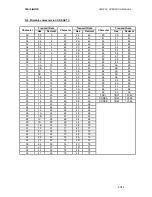
FENIX IMVICO SM2000 OPERATION MANUAL
46/65
GS k m n d1...dn
[Name]
Print bar code
[Format]
ASCII
GS
k
m
n
d
1...
dn
Hex
1D 6B
m n d
1...
dn
Decimal
29
107
m n d
1...
dn
[Range]
65
≤
m
≤
73 (
n
and
d
depends on the bar code system used)
[Description]
Selects a bar code system and prints the bar code.
m
selects a bar code system as follows:
m
Bar Code System
Number of Characters
Remarks
67
JAN13(EAN13)
n
= 12
48
≤
d
≤
57
69
CODE39
1
≤
n
≤
255
48
≤
d
≤
57, 69
≤
d
≤
90, 32, 36,
37, 43, 45, 46, 47
70
ITF
1
≤
n
≤
255(even number)
48
≤
d
≤
57
73
CODE128
2
≤
n
≤
255
0
≤
d
≤
127
[Notes]
•
n
indicates the number of bar code data, and the printer processes
n
bytes from the next
character data as bar code data.
•
If
n
is outside of the specified range, the printer stops command processing and processes
the following data as normal data.
•
If
d
is outside of the specified range, the printer only feeds paper and process the following
data as normal data.
•
If the horizontal size exceeds printing area, the printer only feeds the paper.
•
This command feeds as much paper as is required to print the bar code, regardless of the
line spacing specified by
ESC 2
or
ESC 3
.
•
This command is enabled only when no data exists in the print buffer. When data exists in
the print buffer, the printer processes the data following
m
as normal data.
•
After printing bar code, this command sets the print position to the beginning of the line.
•
This command is not affected by print modes (emphasized, double-strike, underline,
character size, white/black reverse printing, or 90
°
rotated character, etc.), except for
upside-down printing mode.
•
When the system of bar code is used JAN13(EAN13), the printer prints the bar code after
receiving 12 bytes of data of the bar code and processes the following data like normal data.
•
The number of data for code ITF must be even numbers. When an uneven number of byte
of data is introduced, the printer ignores the command.
•
When using the CODE 128 in this printer, take the following points into account for data
transmission:
#
The top of the bar code data string must be code set selection character (any of
CODE A, CODE B or CODE C) which selects the first code set.
#
Special characters are defined by combining two characters "{" and one character.
The ASCII character "{" is defined by transmitting "{" twice consecutively.
Transmit data
Specific character
ASCII
Hex
Decimal
SHIFT
{S
7B, 53
123, 83
CODE A
{A
7B, 41
123, 65
CODE B
{B
7B, 42
123, 66
CODE C
{C
7B, 43
123,67
FNC1
{1
7B, 31
123, 49
FNC2
{2
7B,32
123, 50
FNC3
{3
7B, 33
123,51
FNC4
{4
7B,34
123, 52
“{“
{{
7B, 7B
123, 123
















































